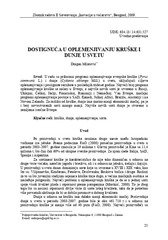Pear and quince breeding achievements in the world
Dostignuća u oplemenjivanju kruške i dunje u svetu
| dc.creator | Milatović, Dragan | |
| dc.date.accessioned | 2021-02-18T11:59:49Z | |
| dc.date.available | 2021-02-18T11:59:49Z | |
| dc.date.issued | 2009 | |
| dc.identifier.uri | http://aspace.agrif.bg.ac.rs/handle/123456789/5786 | |
| dc.description.abstract | U radu su prikazani programi oplemenjivanja evropske kruške (Pyrus communis L.) i dunje (Cydonia oblonga Mill.) u svetu, uključujući ciljeve oplemenjivanja i postignute rezultate u poslednjih trideset godina. Najveći broj progama oplemenjivanja kruške se nalazi u Evropi, a najviše novih sorti je stvoreno u Rusiji, Ukrajini, Češkoj, Italiji, Francuskoj, Rumuniji i Nemačkoj. Van Evrope, značajni programi oplemenjivanja postoje u SAD, Kanadi, Južnoj Africi, Brazilu, Australiji i na Novom Zelandu. Za razliku od kruške, dunja ima znatno manji ekonomski značaj, pa je i broj novostvorenih sorti mnogo manji. Najviše novih sorti dunje je stvoreno u zemljama istočne Evrope. | sr |
| dc.description.abstract | World-wide breeding programmes of European pear (Pyrus communis L.) and quince (Cydonia oblonga Mill.) are reviewed, including major breeding aims and achieved results during last thirty years. Main objectives of pear breeding are: high quality of fruits, precocious bearing and good producitivity, extension of the harvesting period, long storage life, environmental adaptation and resistance to the most dangerous deseases and pests (fire blight, pear scab and pear psylla). The majority of the pear breeding programmes is situated in Europe, and the highest number of new cultivars was released in Russia, Ukraina, Czech Republic, Italy, France, Romania and Germany. Outside Europe, important breeding programmes are located in USA, Canada, South Africa, Brasil, Australia and New Zealand. European pear breeders pay attention primarilly to the fruit quality. North American breeders place greater emphasis on desease resistance (especially fire blight resistance) and cold hardines. The quince is ecconomically less important species than the pear, so the number of newly created cultivars is relatively small. Most of them are created in Eastern European countres. | sr |
| dc.language.iso | sr | sr |
| dc.language.iso | en | sr |
| dc.publisher | Poljoprivredni fakultet Univeriteta u Beogradu | sr |
| dc.publisher | Faculty of Agriculture University of Belgrade | sr |
| dc.rights | openAccess | sr |
| dc.rights.uri | https://creativecommons.org/licenses/by/4.0/ | |
| dc.source | Zbornik radova II Savetovanja „Inovacije u voćarstvu“, Beograd, 2009. | sr |
| dc.subject | kruška, dunja, oplemenjivanje, sorta | sr |
| dc.subject | pear, quince, breeding, cultivar | sr |
| dc.title | Pear and quince breeding achievements in the world | sr |
| dc.title | Dostignuća u oplemenjivanju kruške i dunje u svetu | sr |
| dc.type | conferenceObject | sr |
| dc.rights.license | BY | sr |
| dc.citation.epage | 38 | |
| dc.citation.spage | 25 | |
| dc.identifier.fulltext | http://aspace.agrif.bg.ac.rs/bitstream/id/22786/bitstream_22786.pdf | |
| dc.identifier.rcub | https://hdl.handle.net/21.15107/rcub_agrospace_5786 | |
| dc.type.version | publishedVersion | sr |


